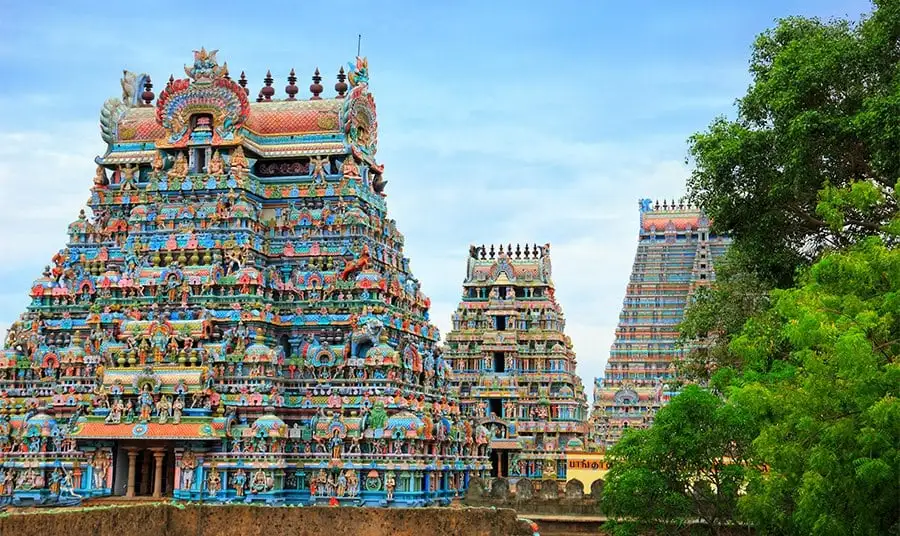




Tiruppur, primarily known as a textile hub in Tamil Nadu, also has several notable temples that attract pilgrims and visitors. Some of the famous temples in and around Tiruppur include:
Location: Avinashi, around 40 km from Tiruppur.
Deity: Lord Shiva (Avinashi Lingeshwarar).
Significance: This ancient temple is one of the most famous temples near Tiruppur. It is known for its history dating back over 1,500 years and is considered one of the seven "Shivasthalams" in Kongu Nadu. The temple is famous for the "Car Festival" (Ther Thiruvizha) held annually in April-May.
Located in Avinashi, about 40 km from Tiruppur, Tamil Nadu.
The presiding deity is Lord Shiva, known here as Avinashi Lingeshwarar.
The temple is also associated with Goddess Karunambigai, the consort of Lord Shiva.
This ancient temple is believed to be over 1,500 years old.
It is considered one of the seven Shivasthalams (sacred places for Lord Shiva) in the Kongu region.
Built in typical Dravidian architectural style, with large gopurams (temple towers) and intricate stone carvings.
The temple complex includes several shrines, corridors, and a sacred tank (temple pond).
The temple has a famous legend related to a miraculous event where Lord Shiva revived a young boy who was swallowed by a crocodile. This miracle is celebrated as part of the temple’s history.
The temple’s Car Festival (Ther Thiruvizha) is held annually in April-May and attracts thousands of devotees from across Tamil Nadu.
It is a grand event, with a large procession of the temple deity through the streets.
It is believed that visiting this temple and offering prayers can help devotees overcome life’s obstacles, particularly related to childlessness and marital issues.
The Avinashi Lingeshwarar Temple is a significant spiritual center, blending rich heritage with deep religious importance.
Location: Tiruppur city.
Deity: Goddess Kadambari Amman.
Significance: This is one of the oldest temples in the region, dedicated to Goddess Kadambari. The temple is particularly popular among locals and tourists alike for the vibrant festivals held here.
Located in Tiruppur, Tamil Nadu.
The temple is dedicated to Goddess Kadambari Amman, a form of Shakti or Devi.
The temple holds significant importance among locals and is one of the prominent temples in Tiruppur.
It is believed that the goddess protects the region and the people, blessing them with health, prosperity, and well-being.
The temple celebrates several vibrant festivals, especially during Navaratri and other auspicious days dedicated to the goddess.
Special pujas and abishkams (ritualistic bathing of the deity) are conducted during these times, drawing large crowds of devotees.
The temple showcases a typical Dravidian architectural style, with beautiful sculptures and carvings that represent the goddess in her powerful and benevolent form.
The temple complex includes a main shrine for Goddess Kadambari and several smaller shrines.
The devotees strongly believe in the divine powers of Kadambari Amman and often visit to seek her blessings for success, family welfare, and protection from evil forces.
The temple plays an important role in the cultural and religious life of the people in Tiruppur, often acting as a center for social and spiritual gatherings.
This temple, with its blend of spirituality and vibrant festivals, holds a special place in the hearts of the people of Tiruppur.
Location: Near Tiruppur, in Sarkar Periyapalayam village.
Deity: Lord Shiva (Sukreeswarar).
Significance: This temple is linked to the Ramayana as it is believed that Sukreeva, the king of Vanaras, worshipped Lord Shiva here to gain strength before his battle with Vali. The temple has a strong mythological connection and is surrounded by natural beauty.
Situated in Sarkar Periyapalayam village, near Tiruppur, Tamil Nadu.
The temple is dedicated to Lord Shiva, worshipped as Sukreeswarar.
The consort of Lord Shiva, Goddess Parvati, is worshipped here as Sokkanayaki Amman.
The temple is associated with the legend of Sukreeva, the king of the Vanaras in the epic Ramayana.
It is believed that Sukreeva worshipped Lord Shiva here to gain strength before his battle with his brother Vali.
This temple is considered ancient and holds significant religious value, especially for its connection to Hindu mythology and the Ramayana.
The temple has a rich history, and many believe it was built during the medieval Chola period, reflecting the Dravidian architectural style.
The temple has a traditional Dravidian architecture with a tall gopuram (tower) and beautifully carved pillars and sculptures depicting various mythological figures.
The serene environment surrounding the temple adds to its spiritual charm.
Shivaratri is celebrated with grandeur in this temple, attracting a large number of devotees.
Other important festivals related to Lord Shiva are also observed with various rituals and celebrations.
The temple is believed to provide peace, prosperity, and the removal of obstacles for devotees who worship Lord Shiva here.
It is a sacred spot for people seeking spiritual growth and divine blessings.
The Sukreeswarar Temple is not only a spiritual hub but also a place rich in history and mythology, attracting devotees and pilgrims throughout the year.
Location: Chennimalai, around 30 km from Tiruppur.
Deity: Lord Murugan.
Significance: This is one of the most famous Murugan temples in the region, known for its scenic hilltop location. Devotees often take a pilgrimage here to receive the blessings of Lord Murugan. The hill provides a panoramic view of the surrounding countryside.
Situated on Chennimalai Hill, around 30 km from Tiruppur, Tamil Nadu, and about 26 km from Erode.
The temple is dedicated to Lord Murugan, also known as Dhandayuthapani in this temple, who is widely worshipped in Tamil Nadu as the god of war and victory.
The temple is located on a hilltop at an altitude of around 400 meters (1,350 feet), offering panoramic views of the surrounding countryside.
Devotees can reach the temple by climbing 1,320 steps, or they can drive up via a motorable road.
According to legend, the sage Agastya was advised by Lord Murugan to build this temple. It is believed that Lord Murugan appeared to Agastya in the form of a Vel (divine spear) on Chennimalai Hill.
The temple celebrates the Thai Poosam festival (January-February) with great devotion, where thousands of devotees carry Kavadi (burdens symbolizing their devotion).
Other important festivals include Panguni Uthiram (March-April), Skanda Shashti, and Vaikasi Visakam (May-June).
The temple follows traditional Dravidian architecture, with large gopurams (towers) and intricate stone carvings.
The temple complex has several halls, shrines, and a sacred theertham (temple pond).
The temple is considered one of the most powerful Murugan shrines in Tamil Nadu. Devotees believe that worshipping here can help them overcome obstacles, gain courage, and receive Murugan’s blessings for success in life.
It is a popular pilgrimage site, especially for those undertaking Kavadi offerings.
Chennimalai Murugan Temple is a significant spiritual center, blending scenic beauty, religious importance, and cultural heritage, making it a must-visit for devotees and tourists alike.
Location: Near Tiruppur.
Deity: Lord Murugan.
Significance: This temple is well-known for the divine presence of Lord Murugan and draws devotees from surrounding areas. The temple’s serene environment and its religious importance make it a must-visit.
Situated in Kariyapatti, a village near Tiruppur, Tamil Nadu.
The temple is dedicated to Lord Murugan, the Tamil god of war and wisdom, also known as Subramanya.
The temple holds great significance for the local community, with a strong belief in Lord Murugan’s power to provide protection and blessings.
It is a prominent place of worship for nearby villagers, drawing many devotees from Tiruppur and surrounding regions.
The temple celebrates major festivals like Thaipusam, Panguni Uthiram, and Skanda Shashti with much devotion.
Kavadi Attam (a form of devotional sacrifice) is a popular ritual performed during festivals, where devotees carry a decorated structure (Kavadi) as an offering to Lord Murugan.
Devotees visit the temple to seek Lord Murugan’s blessings for overcoming life challenges, success in endeavors, and overall well-being.
The temple is also visited for special prayers related to family welfare and prosperity.
While the temple is relatively modest in size, its spiritual atmosphere and serene environment make it a peaceful retreat for worshippers.
The surrounding natural beauty adds to the charm and divine ambiance of the temple.
The temple serves as a center for religious and cultural activities in the region, strengthening the local community’s ties and devotion to Lord Murugan.
The Kariyapatti Murugan Temple is an important religious landmark in the Tiruppur region, revered for its spiritual atmosphere and the belief in Murugan’s powerful blessings.
These temples in and around Tiruppur are known for their cultural, religious, and historical significance.